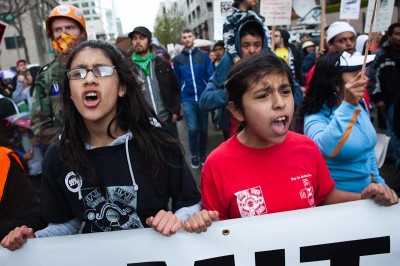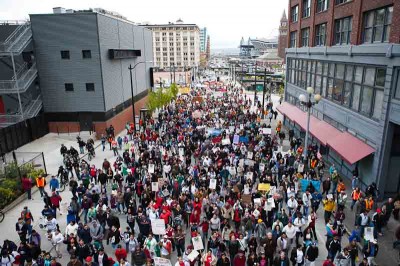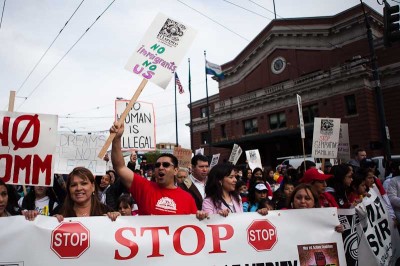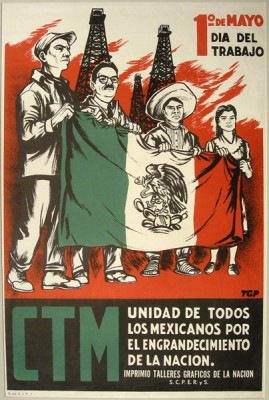
More than 80 countries officially celebrated International Worker’s Day yesterday. Demonstrators from Chile to the Philippines, Spain to Tunisia called for everything from higher wages to the overthrow of corrupt leaders.
The May Day holiday is not officially observed in the US. Instead, we have Labor Day, which started in the late 1800’s as a quiet observance of the contribution of workers, but has since become more about Bumbershoot, back to school sales and something about not being allowed to wear white anymore.
But that didn’t stop members of Seattle’s working class from taking to the streets Tuesday evening to speak out in support of immigration rights and to protest the US’s dreary economic climate and job market.
The group of about a thousand marched from Judkins Park in the Central District to the front of the Federal Building in downtown Seattle where they joined in with the rallies that had been taking place there throughout the day.

The mood was festive, which stood in stark contrast to other May Day events earlier in the day, when a small group of black block anarchists vandalized storefronts in downtown Seattle – smashing the front windows of Nike Town and the neighboring American Apparel store – before returning to Westlake Park where they stripped from their all-black clothing and scattered into the crowd that had gathered to peacefully demonstrate and listen to various speakers and musicians.
The short-lived mayhem made national news (yes, we know you already heard about it), prompted Mayor McGinn to declare a state of emergency and brought out Seattle’s superhero community to keep the peace.
Many who gathered at Judkins Park were upset with the outbreak of violence earlier, but were determined to end the day of protests on a positive and more productive note.
The group, which consisted of hundreds of demonstrators, was led by El Comité President Jorge Quiroga, who led the group in both Spanish and English chants such as “Si se puede” (Yes we can) and “No justice, no peace”.

“They tried to make this into something else,” said Quiroga referring to the myriad of issues being protested against throughout the day in Seattle, “Immigration reform is the issue … we want to make sure people receive that message.”
Seattle Central Community College economics professor Kshama Sawant, who joined the march, also wanted to keep the day focused on worker’s rights and well-being.
“The most glaring problem that we are facing is the massive jobs crisis,” said Sawant. “The financial collapse – engineered by the big banks…became a global economic collapse and the way it works is that all the burden is put on the backs of ordinary people.”
Many students were also in the crowd. Nick Peterson, a Seattle University student who participated in a walkout from class earlier in the day cited a feeling of accountability to skip class to join the demonstrations.
“I have the privilege of going to a good school and…I have an obligation to speak out,” said Peterson, adding that he felt much of the working class did not have the same opportunities as him, which left him with a responsibility to stand up for them.
Fellow protester, Mike Carlson chose to attend the May Day protests because of what he saw as a need for the U.S. to become more involved in the global day of demonstrations.

“We’re trying to bring International Worker’s Day back here to the States and into the public eye,” said Carlson who is a member of the Red Spark Collective group that meets weekly to discuss the revolutionary transformation of society.
Michael Lapointe, who works at Cocoon House, a non-profit homeless shelter in Everett, has felt the sting of a tightening economy and decreased budget. Recent struggles have forced Cocoon House, which provides housing for homeless youth, to layoff many of their employees.
“The workers are being screwed by the system,” said Lapointe, “They are being treated as a commodity but, really, we are the people who build this community.”
Looking around Seattle’s Westlake Park in the early afternoon before the march from Judkins Park took place, Lapointe was pleased with the turnout.
“This is a success right now.”


Great piece Ian, putting the focus back where it should be!
In other (not from The Onion) news, the President declared yesterday to be Loyalty Day: http://www.whitehouse.gov/the-press-office/presidential-proclamation-loyalty-day
Phoenix didn’t keep “the peace,” that asshole was threatening folks with pepper spray.